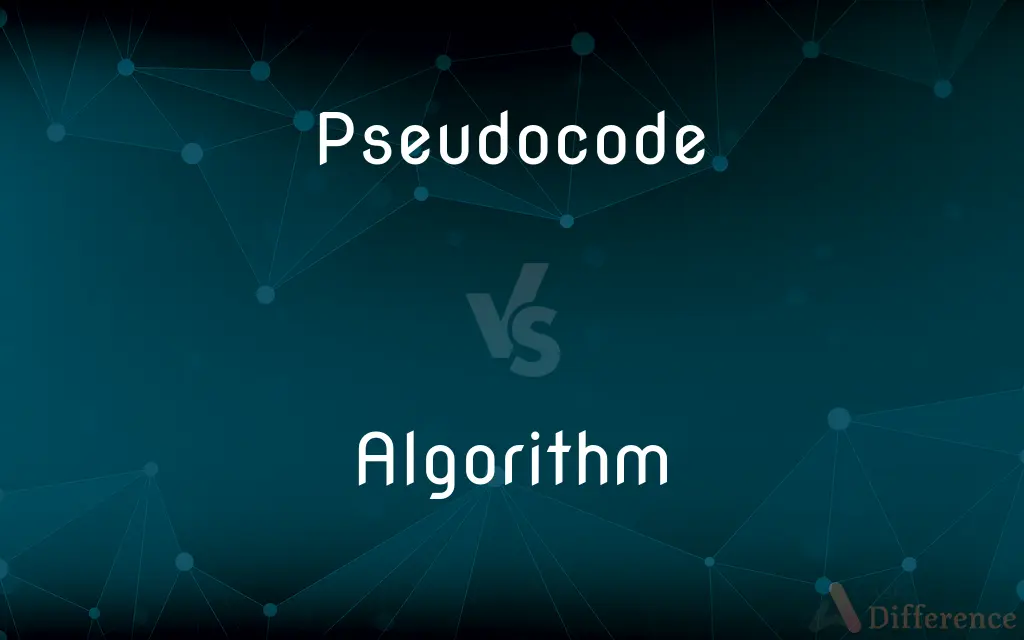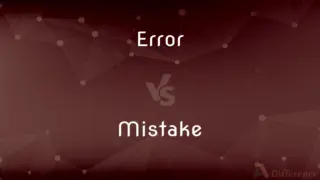Pseudocode vs. Algorithm — What's the Difference?
By Tayyaba Rehman & Fiza Rafique — Updated on March 15, 2024
Pseudocode is a human-readable representation of a program's logic, not bound by syntax rules, while an algorithm is a step-by-step procedure to solve a problem, applicable in any programming language.

Difference Between Pseudocode and Algorithm
Table of Contents
ADVERTISEMENT
Key Differences
Pseudocode simplifies the expression of algorithms, using natural language elements and general programming conventions to outline a program's flow. An algorithm, on the other hand, is a formalized set of steps designed to perform a task or solve a problem.
While pseudocode is one way to represent an algorithm, the latter is a broader concept that encompasses any precise, step-by-step procedure for solving a problem, regardless of how it's documented. Algorithms are fundamental in computer science, underlying the operations of software and systems, and can be implemented in various programming languages following their logic precisely.
Pseudocode often uses control structures like loops and conditionals in a way that closely mirrors programming languages but without strict syntax, making it accessible to people with varying coding backgrounds. Algorithms focus on the logic and sequence of operations necessary to achieve a result, which can then be translated into actual code in a programming language, ensuring that the desired outcome is achieved efficiently and effectively.
While pseudocode is primarily a communication tool that helps programmers and designers convey ideas about how a program should work, an algorithm is a conceptual entity that exists independently of any specific programming language or notation. The transition from algorithm to code involves translating the high-level logic detailed in pseudocode (or another form of algorithm representation) into the syntax and structures of a specific programming language.
Both pseudocode and algorithms play critical roles in the development of software and computational solutions. Pseudocode acts as a bridge between the theoretical design of algorithms and their practical implementation, offering a language-agnostic way to design and review program logic. Algorithms, being the core ideas behind program functionality, are essential for creating efficient and effective software solutions, with their principles applicable across different technologies and platforms.
ADVERTISEMENT
Comparison Chart
Purpose
To simplify the expression of algorithms for human understanding.
To define a set of steps for solving a specific problem.
Format
Informal, mimics programming logic without strict syntax.
Formal, can be expressed in natural language, pseudocode, flowcharts, etc.
Execution
Cannot be executed by computers; meant for human reading.
Can be implemented and executed in a programming language.
Usage
Used for planning and discussing algorithms, and as a step in program development.
Used to solve problems in computer science and programming.
Flexibility
Highly flexible, adjusts according to the writer's preferences.
Must be precise and unambiguous to ensure correct implementation.
Compare with Definitions
Pseudocode
An intermediate step between problem-solving and coding, aiding in algorithm visualization.
Initialize sum to 0. For every number in numbers, add it to sum.
Algorithm
A finite set of instructions designed to perform a task or solve a problem.
To find the greatest common divisor of two numbers, use Euclid's algorithm.
Pseudocode
A tool for algorithm design that focuses on logic rather than code specifics.
For each item in the list, if the item is red, add it to the redItems list.
Algorithm
The underlying logic behind software functionalities and system operations.
A pathfinding algorithm determines the shortest route from point A to B.
Pseudocode
A notational system for algorithms that mimics programming languages but is simpler and not bound by specific syntax.
If the user's input is positive, print Positive.
Algorithm
Can be represented in various forms, including pseudocode, flowcharts, and code.
The algorithm for adding two numbers is to start with the first number and increase it by the second number.
Pseudocode
A method for explaining a program's logic in a way that's accessible to diverse programming backgrounds.
Check if the number is greater than 10. If true, print Greater than 10.
Algorithm
A foundational concept in computer science, essential for programming and software development.
Sorting algorithms, like quicksort, efficiently organize data.
Pseudocode
A bridge between the theoretical aspects of algorithms and their practical implementation.
While there are unvisited nodes, visit the next unvisited node.
Algorithm
Must be precise, unambiguous, and have a defined input/output.
An encryption algorithm transforms plain text into encrypted text using a key.
Pseudocode
In computer science, pseudocode is a plain language description of the steps in an algorithm or another system. Pseudocode often uses structural conventions of a normal programming language, but is intended for human reading rather than machine reading.
Algorithm
In mathematics and computer science, an algorithm ( (listen)) is a finite sequence of well-defined, computer-implementable instructions, typically to solve a class of specific problems or to perform a computation. Algorithms are always unambiguous and are used as specifications for performing calculations, data processing, automated reasoning, and other tasks.
Pseudocode
(computing) A description of a computer programming algorithm that uses the structural conventions of programming languages but omits detailed subroutines or language-specific syntax.
Algorithm
A finite set of unambiguous instructions that, given some set of initial conditions, can be performed in a prescribed sequence to achieve a certain goal and that has a recognizable set of end conditions.
Algorithm
(countable) A collection of ordered steps that solve a mathematical problem. A precise step-by-step plan for a computational procedure that possibly begins with an input value and yields an output value in a finite number of steps.
Algorithm
Calculation with Arabic numerals; algorism.
Algorithm
A precise rule (or set of rules) specifying how to solve some problem; a set of procedures guaranteed to find the solution to a problem.
Algorithm
A precise rule (or set of rules) specifying how to solve some problem
Common Curiosities
What is an algorithm?
An algorithm is a precise, step-by-step procedure for solving a problem or performing a task, which can be implemented in programming languages.
How do pseudocode and algorithms differ?
Pseudocode focuses on readability and simplicity, primarily for human understanding, while algorithms are about the fundamental steps of solving problems, which can be formally implemented in code.
Why is pseudocode useful?
Pseudocode is useful for planning and visualizing the logic of algorithms without getting bogged down by the syntax of a specific programming language.
Is pseudocode standardized?
No, there is no strict standard for pseudocode; its format and style can vary based on the preferences of the writer or the conventions of the team.
Are algorithms specific to computer science?
While algorithms are fundamental to computer science, the concept of a step-by-step procedure to solve problems is applicable in various fields beyond programming.
Can an algorithm be represented in different ways?
Yes, an algorithm can be represented in natural language, pseudocode, flowcharts, and directly in programming code, among others.
Can pseudocode be executed on a computer?
No, pseudocode cannot be executed directly by a computer; it must first be translated into a programming language.
What is pseudocode?
Pseudocode is a simplified, informal way of describing a computer program or algorithm, using a combination of natural language and programming language conventions without strict syntax.
What role does pseudocode play in programming?
Pseudocode helps programmers and developers conceptualize and communicate the logic of their programs before coding, facilitating a clearer and more efficient development process.
Can algorithms be inefficient or poorly designed?
Yes, algorithms can be inefficient or flawed in design, leading to slow performance or incorrect outcomes, highlighting the importance of thorough testing and optimization.
How do algorithms improve software development?
Algorithms provide a clear set of instructions for solving problems, which helps in developing efficient and reliable software.
How do programmers use algorithms?
Programmers use algorithms as blueprints for writing efficient and effective code to solve specific problems.
Do all programmers use pseudocode?
Not all, but many programmers use pseudocode as part of their planning process, especially for complex algorithms or when collaborating with others.
Share Your Discovery

Previous Comparison
Clean vs. Cleanse
Next Comparison
Error vs. MistakeAuthor Spotlight
Written by
Tayyaba RehmanTayyaba Rehman is a distinguished writer, currently serving as a primary contributor to askdifference.com. As a researcher in semantics and etymology, Tayyaba's passion for the complexity of languages and their distinctions has found a perfect home on the platform. Tayyaba delves into the intricacies of language, distinguishing between commonly confused words and phrases, thereby providing clarity for readers worldwide.
Co-written by
Fiza RafiqueFiza Rafique is a skilled content writer at AskDifference.com, where she meticulously refines and enhances written pieces. Drawing from her vast editorial expertise, Fiza ensures clarity, accuracy, and precision in every article. Passionate about language, she continually seeks to elevate the quality of content for readers worldwide.














































